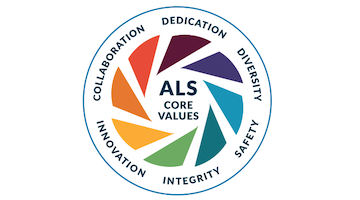
I looked at the ALS director’s reports from the last two years before I started writing this column for ALSNews. The January 2020 update was bubbling with many great things going on at the ALS: our Science Council’s drive to enhance partnerships with the user community; our IDEA (inclusion, diversity, equity, and accountability) Committee activities to ensure well-supported, dedicated, and productive staff and user communities; and the ALS Upgrade (ALS-U) progress to support leading technical capabilities for years to come. By contrast, last year’s update started with a lament about trying to work from home while being followed endlessly by our two old dogs and competing for bandwidth with my wife to participate in Zoom meetings. As you know all too well, the last two years have been a challenging roller coaster ride.
I am happy to report that the ALS is emerging from the pandemic, perhaps a little battered but certainly not broken. Let me pick up several positive threads from the previous updates.
For the first time since the beginning of the pandemic, the ALS supported user operations on a nearly normal schedule for three months last fall, with a population of mostly domestic users not far below our norm. We are starting to bring in new cohorts of doctoral and postdoctoral fellows, forming some new Approved Program partnerships, and thinking hard about how to invest our limited resources in support of existing and new capabilities. Sometimes it almost feels normal, and indeed, the ALS is moving towards initiating the Lab’s “future of work” model this spring. So, a new normal is approaching, though now with a distribution of work modes and plans for how to deal with new viral strains and infection peaks.
The ALS-U Project continues to make great progress and is anticipating its critical decision (CD)-3 review (in support of approval to start construction) late this summer. Many new assemblies associated with the new accumulator ring and injector are already being installed. As you are painfully aware, much of the progress has required longer-than-normal shutdowns, which has cut into user operations. I acknowledge the pain this is causing for ALS staff, partner staff, and most notably users. I encourage long-term thinking about this: the ALS-U Project, despite its current disruptions, will leave the ALS with a new, state-of-the-art accelerator, with many upgraded subsystems, with several new or upgraded beamlines, more upgrades being planned, and, perhaps most importantly, a cadre of LBNL staff trained to maintain, optimize, and operate all these new powerful and complex systems.
ALS-U is a huge vote of confidence from our primary sponsor, the Basic Energy Sciences (BES) program of the Department of Energy’s Office of Science. Because of the upgrade, the ALS will be in operation, working with users and pushing forward the frontiers of x-ray science, for several more decades. The ALS will remain the flagship soft x-ray facility in the BES complex, with powerful tools ranging from the infrared through hard x-ray regimes, for a very long time. And staff and users will continue to drive that excellence, as they have for the last 29 years.
To help facilitate that collaborative future, we have started to update our partnership policy, which presently dates back to about 2000. We will probably end up with more than one partnership model, and for each we will clearly define the benefit to the ALS and to the partners. We look forward to collaborating with partners to develop new tools, capabilities, and protocols, to accomplish world-class science, to increase the expertise of the user community, and to help improve professional development and work-life balance for our staff. Please watch for workshops, led by the ALS Science Council, that will focus on developing new partnerships in a variety of science areas. This process will be very important for to the ALS, before and long after the upgrade.

I believe we will not be as productive and as innovative as we should be without a strong ALS climate that reflects our core values shown on the right. I am very proud of the efforts made by our IDEA Committee, even during the pandemic, to lay the groundwork necessary to achieve this, and I encourage you to visit their web page to see what they have been up to. I want in particular to highlight that ALS staff have played key roles in starting the Energy Sciences Area mentorship and internship programs. Increasingly we are looking outward to collaborate in this area. With major participation from the ALS staff, LBNL is participating in the American Physical Society’s IDEA program. And recently, with other BES light sources, we have established a working group on diversity to develop best practices and to engage more broadly across the entire light source community.
I want to close by noting the obvious: this director’s report is one month late because last month I communicated in ALSNews my intention to retire later this year. What’s written above indicates there are many initiatives in progress at and around the ALS that I care deeply about. I have no doubt that many of these will continue after I retire, because they are the right thing to do and because many ALS staff and users care deeply about them. But it is time for me to slow down a bit and smell the rhododendrons, and to be engaged in a little science on the side. It has been an honor to serve on the ALS management team for nearly the last 10 years, and wonderful to work with the ALS staff and community to help make the ALS all it can be.